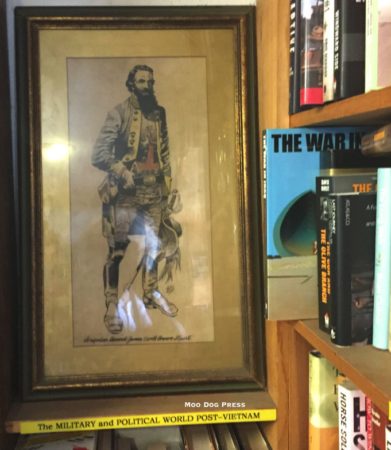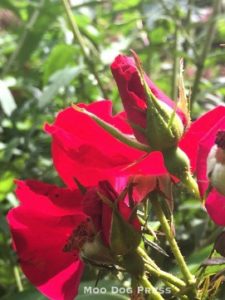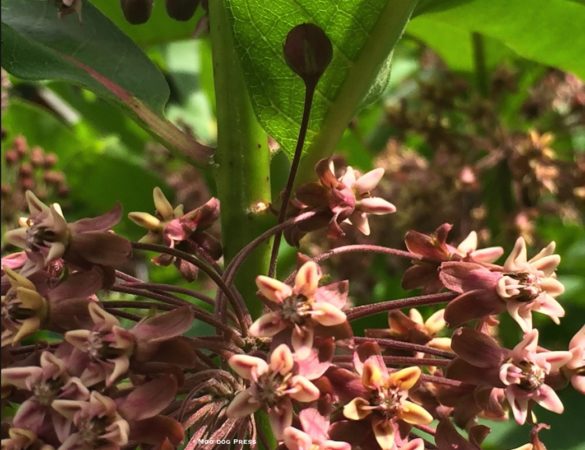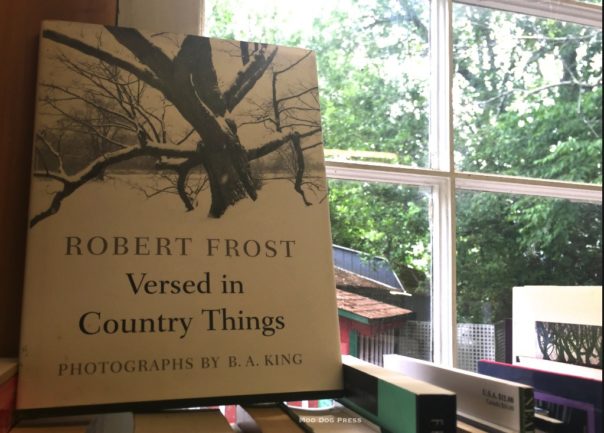His Ride Is Over. Books Hold Safe Lives Lived; ‘Versed in Country Things’
J.E.B. Stuart, we meet again.
When by chance a rendering of this gifted horseman was seen tucked in a corner of a shop, the encounter invoked a smile. Having lived in Virginia and Maryland where the Civil War seems recent history, battlefields are living textbooks to walk, study and learn from – and farmland still yields traces of the clashes – “seeing” J.E.B. Stuart with his boots on and ready to ride was startling.
“James Ewell Brown Stuart was born 1833 in Patrick County, Virginia. From 1848 to 1850 he attended Emory and Henry College and entered the U.S. Military Academy (better known by a more popular term – West Point) on July 1, 1850. In the years that followed his graduation, Stuart received various commissions in Texas, Kansas, and Washington. On Jan. 15, 1861, Stuart made the move which would determine his role in the Civil War. On this date he wrote to Jefferson Davis requesting a position in “The Army of the South”. On May 3, 1861 Stuart sent his letter of resignation to the U.S. Army, and on May 24 he was named captain of the Confederate Calvary.
“J.E.B. Stuart won much praise in the Battle of Second Manassas (called Bull Run by the North). According to General Robert E. Lee, Stuart was an ideal soldier; and because of his skill as an intelligence officer, Lee regarded him as the “eyes of the army”. Dramatic in his appearance, Stuart always rode a grand horse, lined his gray coat with red material, wore his hat cocked to one side with a peacock's plume splaying from it, and always had a red flower or ribbon love-knot in the lapel of his jacket.” – Dictionary of American Biography
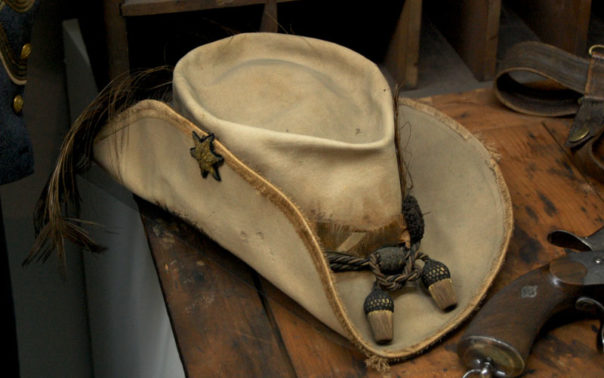
His sweat-stained hat, now at rest and preserved for viewing, sports a plumed feather that has seen better days.
The course of events in a life can carry a person along like a raging river; easy to judge from a comfortable chair in modern day living; not to easy to live it. Read deeper and reserve judgment, soak up the stories, slip out of time and into another's skin.
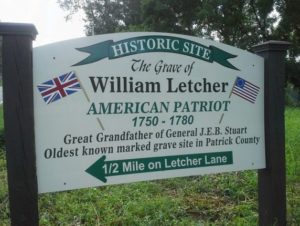
His great grandfather William Letcher fought in the war for independence. People and their heritage are complicated. Image linked to site about the farm and Stuart's birthplace, where he was raised by a mother who loved growing gardens seeing them flower.
Stuart's likeness, captured by an artist and now framed and behind glass, seems ready for action, but is flanked only by bookshelves. Legendary for his horsemanship, flair and daring, here are names of his mounts: Highfly, George, General, Skylark, Virginia, My Maryland, Lily, Lady Margrave, Chancellor, Mazeppa.
There is one unnamed steed that was mentioned in his correspondence. Here is a link to the more detailed listing (PDF) compiled by Robert J. Trout.
Reading and connecting landscapes to lives lived brings people back to life. It is time travel of sorts to visit places where unmentionable battles took place; but to read about a person is to sketch in shades of what made them move and act. What shaped them.
“Regarding his mother and boyhood: She inherited from her grandfather, William Letcher, a beautiful and fertile farm in the southwestern part of Patrick County, which was named ‘Laurel Hill.' Here her children were born.
“The large and comfortable house was surrounded by native oaks and was beautified with a flower garden, which was one of the childish delights of her son, James, to whom she had transmitted her own passionate love of flowers. The site commanded a fine view of the Blue Ridge Mountains, and near at hand was the monument erected to the memory of William Letcher by his daughter, Bethenia. Amid these surroundings James Stuart passed a happy boyhood.
“He loved the old homestead with all the enthusiasm of his nature; and one of the fondest dreams of his manhood was that he might own the place of his birth, and there end his days in quiet retirement. He writes thus to his mother from Fort Leavenworth, in 1857: I wish to devote $100 to the purchase of a comfortable log church near your place, because in all my observation I believe one is more needed in that neighborhood than any other that I know of; and besides, “charity begins at home.” Seventy-five of this $100 I have in trust for that purpose, and the remainder is my own contribution. If you will join me with $25, a contribution of a like amount from two or three others interested will build a very respectable free church. . . .”
“A near relative writes, ‘I well remember his speaking thus to his brother in 1863: ‘I would give anything to make a pilgrimage to the old place, and when the war is over quietly to spend the rest of my days there.'” – from The Life and Campaigns of Major-General J. E. B. Stuart: Commander of the Cavalry of the Army of Northern Virginia by H. B. (Henry Brainerd) McClellan, 1840-1904, pages 5 and 6, published 1885.
It was not to be.
The New York Times reported on his death in a “long obituary of Stuart — whom the rebels call the ‘flower of Cavaliers'” – via a clip from the Richmond Examiner, which included “Gen. Stuart was about 35 years of age.”
“The hardest thing to see is what is in front of your eyes.” – Johann Wolfgang von Goethe
When all the clamor of manmade noise subside and displays of firearms, clashes of power, fireworks even are but a memory, Mother Nature keeps on growing strong.
The descriptive power of one man's life the countryside and farmland of a state, with a mother who loved gardening – all provoked by another person's depiction of the adult man, collected and displayed by yet another person. Maybe by sheer chance.
With that in mind, here are gardens carefully tended by those who love books and the written word.
Bee balm is a perennial (that means it returns each year and also spreads if encouraged) that explodes with color – and the floral displays attract hummingbirds, butterflies, bees, hummingbird moths. The spicy oregano-like scent to the leaves is an added bonus.
“Although somewhat bitter due to the thymol content in the leaves and buds, the plant tastes like a mix of spearmint and peppermint with oregano. Bee balm was traditionally used by Native Americans as a seasoning for wild game, particularly birds.” – Wikipedia
There's fern-y fennel, which swallowtail caterpillars love to munch. Time transforms the distinctively marked caterpillar into a swallowtail butterfly – one reason why planting a packet or two of fennel can be rewarding to all involved. Encourage the living jewels of plants, which in turn draw more species of creatures which feed and live on them.
A poem called The Need of Being Versed in Country Things by Robert Frost
“The house had gone to bring again
To the midnight sky a sunset glow.
Now the chimney was all of the house that stood,
Like a pistil after the petals go.
“The barn opposed across the way,
That would have joined the house in flame
Had it been the will of the wind, was left
To bear forsaken the place’s name.
“No more it opened with all one end
For teams that came by the stony road
To drum on the floor with scurrying hoofs
And brush the mow with the summer load.
“The birds that came to it through the air
At broken windows flew out and in,
Their murmur more like the sigh we sigh
From too much dwelling on what has been.
“Yet for them the lilac renewed its leaf,
And the aged elm, though touched with fire;
And the dry pump flung up an awkward arm;
And the fence post carried a strand of wire.
“For them there was really nothing sad.
But though they rejoiced in the nest they kept,
One had to be versed in country things
Not to believe the phoebes wept.
Frost had country ways and life bred in his bones and had no choice but to call forth torrents of the words, now captured between covers and featured online for others to ponder. To those interested, there are readers interpretations of this poem who interpret the meaning – their opinions are listed on Modern American Poetry.
Books and book and books and books. A writer is a reader; a reader feeds a writer. To weave life into stories, song, poems, lyrics, movies, film, documentaries, spoken word, plays, recollections – a human must ingest reams of real life – and the natural world feeds that appetite s well. Books, conversations, listening to music, standing in line eavesdropping, and coincidental meetings – all become transformed and released again – a river of work mixes and mingles and feeds others in return.

